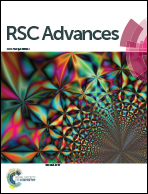Investigation of the effect of S/In molar ratio on physical properties of sprayed In2S3 thin films
Abstract
Indium sulfide (In2S3) thin films have been synthesized on glass substrates using the spray technique (CSP). The S : In molar ratio was varied from 1 to 4 in the starting solution. The Raman analysis confirms the formation of the β-In2S3 material and the absence of a secondary phase. The EDS analysis reveals that our layers are pure. The thin film surface is free of cracks, as observed in AFM images. Optical transmission achieved 80% in the visible and near infrared region. The refractive index (n) is affected by the changes in the S/In molar ratio. The optical parameters, single oscillator energy (E0), dispersion energy (Ed) and high frequency dielectric constant (ε∞), are calculated via the Wemple–DiDomenico model. In addition, the photoconductivity kinetics in In2S3 films for S/In = 2 were investigated and analyzed. The I–V characteristics and the photoresponse were also studied.



 Please wait while we load your content...
Please wait while we load your content...